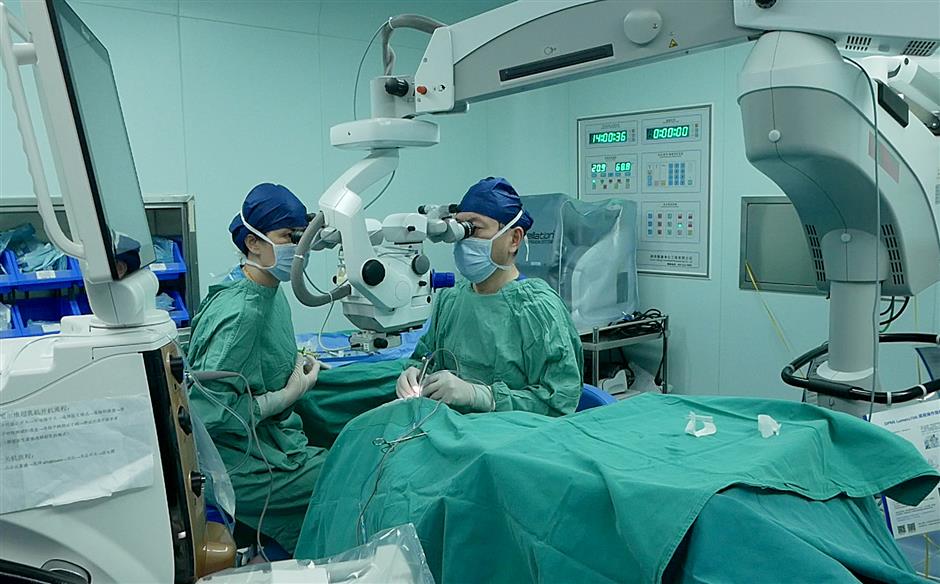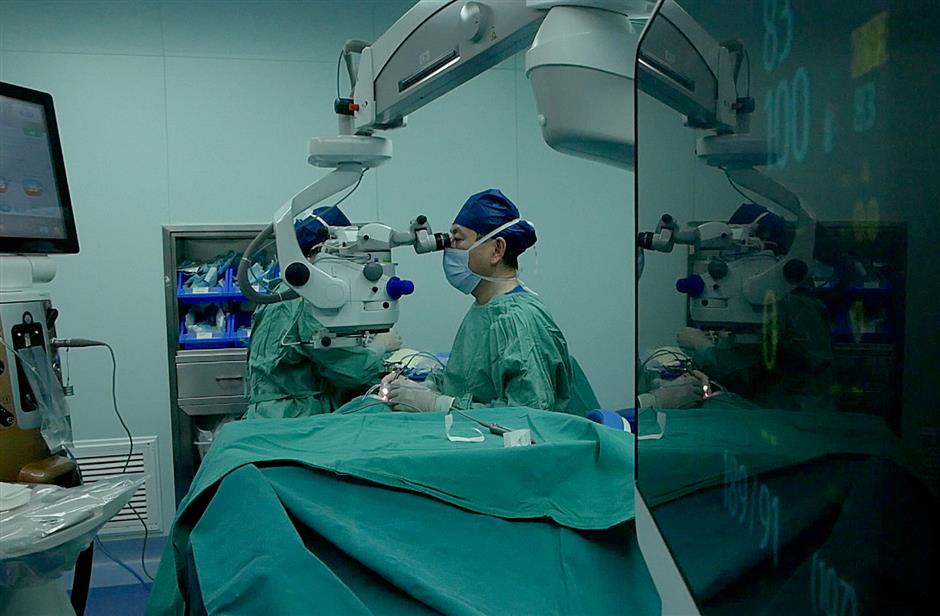今日上海
智能药物帮助预防和治疗眼部疾病 - 2023年08月14日
Smart medicine helping prevent and cure eye disorders
Editor's note:
Information technology, artificial intelligence and big data are playing increasingly significant roles in health care. This series on many sectors of the health industry is intended to demonstrate the role of advanced technology, intelligent systems and new inventions.
Intelligent technology is making eye disease detection, diagnosis and treatment more efficient, accurate and precise.
According to the Chinese Medical Association, the incidence of cataracts among Chinese between 60 and 89 years of age is about 80 percent. With the rising aging population, there is also a rise in cataract cases. In 2020, there were more than 3,000 cataract surgery patients per million people in the country, a figure that had increased nearly 38 times over the previous 30 years.

Doctors follow the guidance shown on a computer screen to conduct key steps of cataract surgery.
Presbyopia, which starts from the age of 38 with the loss of near vision due to aging, affects almost all Chinese over 52 years old.
Cataracts are a leading eye disease for the elderly and the top reason for blindness. About 46 percent of blindness is caused by cataracts. About 200 million elderly Chinese over 60 suffer both presbyopia and cataracts.
The aging of eyes can't be treated by medicine. Surgery is the only solution.
Eye surgery is a process requiring knowledge, experience, skills and sometimes luck, because human beings are not machines.
Even the most experienced doctors can't ensure 100 percent success of each surgery. But smart medicine is here to reduce the risk of fault and improve treatment outcomes.
"Previously, the whole process of cataract surgery is a manual process, mainly depending on surgeons' skills and experiences," said Dr Lu Yi from Bright Eye Hospital. "There can be mistakes, faults and not-so-perfect performance.
"Smart medicine now is guiding doctors on all crucial steps. In the femtosecond laser-assisted cataract surgery, we just need to follow the guidance shown on the computer screen to perform the operation. It offers a greater level of precision and repeatability than manual techniques, like incisional astigmatism management, lens centration and reduced effective phaco energy.
"More accurate and precise operation also ensures less complications and patients' better and quicker recovery," Lu added.

Dr Lu Yi, from Bright Eye Hospital, performs a smart medicine-assisted cataract surgery.
Smart medicine has also been adopted on eye disease screening for early detection, diagnosis and treatment at the grassroots. Artificial intelligent is now adopted to achieve a quick and convenient screening in diabetic retinopathy, cataract and glaucoma.
In Shanghai, a community-district-city intervention and management system is being established to achieve classified health services through the assistance of AI and big data.
More than 70 neighborhood health centers in the city have adopted AI-based eye health management to promote a community-based eye disease screening that allows residents to finish self-served screening through a 5-minute check under the guidance of general physicians.
The system can provide a diagnosis report within 20 seconds and relevant suggestions, based on which GPs can arrange further treatment and hospital transfers in line with the screening result for early detection and timely treatment.
Smart medicine helping prevent and cure eye disorders
Dr Jorn Slot Jorgensen, from EuroEyes, performs a presbyopia surgery.
With medical developments and people's rising demand for quality of life, cataract and presbyopia surgery has grown from a traditional eyesight-recovery operation to a precise refractive surgery for better vision and a more convenient life. More developed technologies are being introduced and developed to meet people's demand, experts said.
"We are bringing the latest technology from Germany to China," said Dr Jorn Slot Jorgensen from EuroEyes. "The presbyopia laser surgery can treat people in the age group of 38 and 45 for early intervention of presbyopia."
For people with presbyopia older than 45, the advanced trifocal lens provides a range of near, intermediate, and distance vision without the need for glasses after surgery. Moreover, the new technology will help middle-aged and elderly people to cure their presbyopia and treat or prevent cataracts, as the implanted lens will not age, he added.
Source: Shanghai Daily
